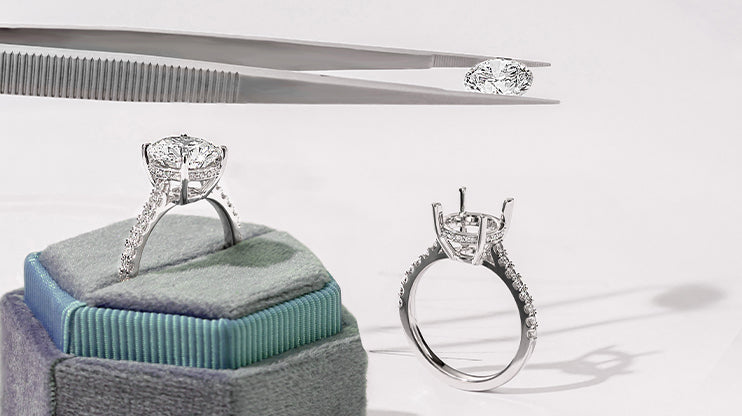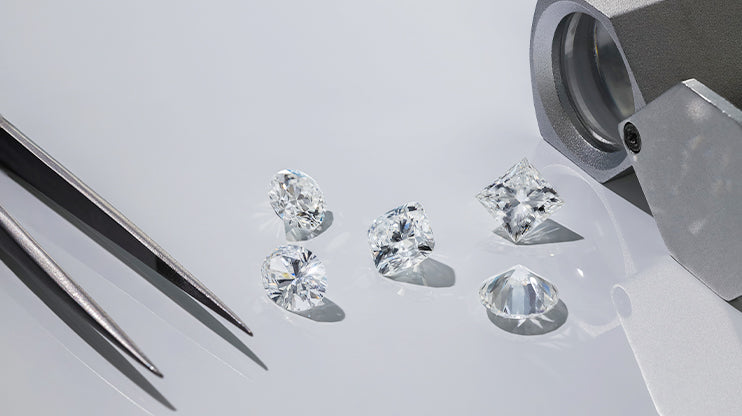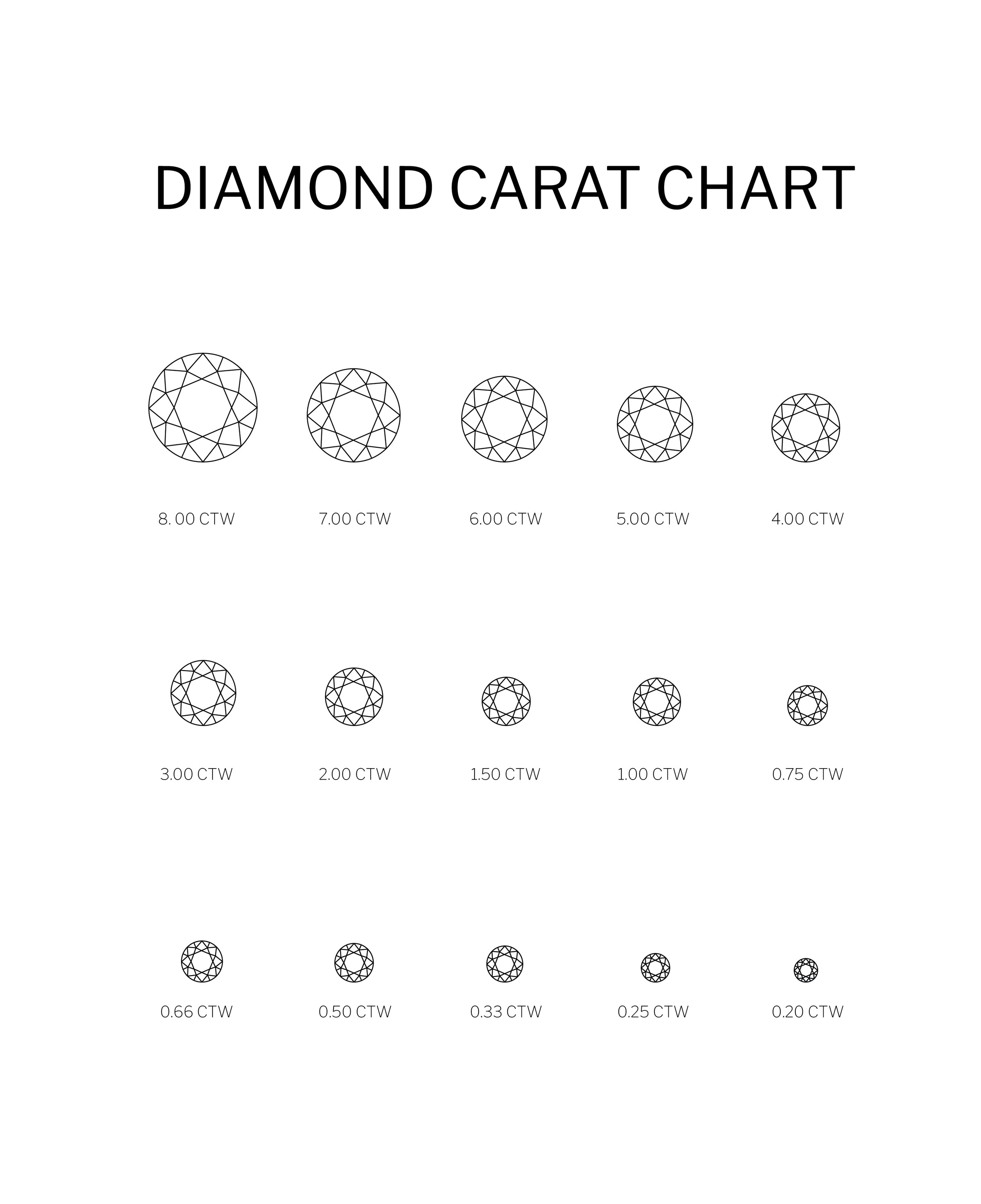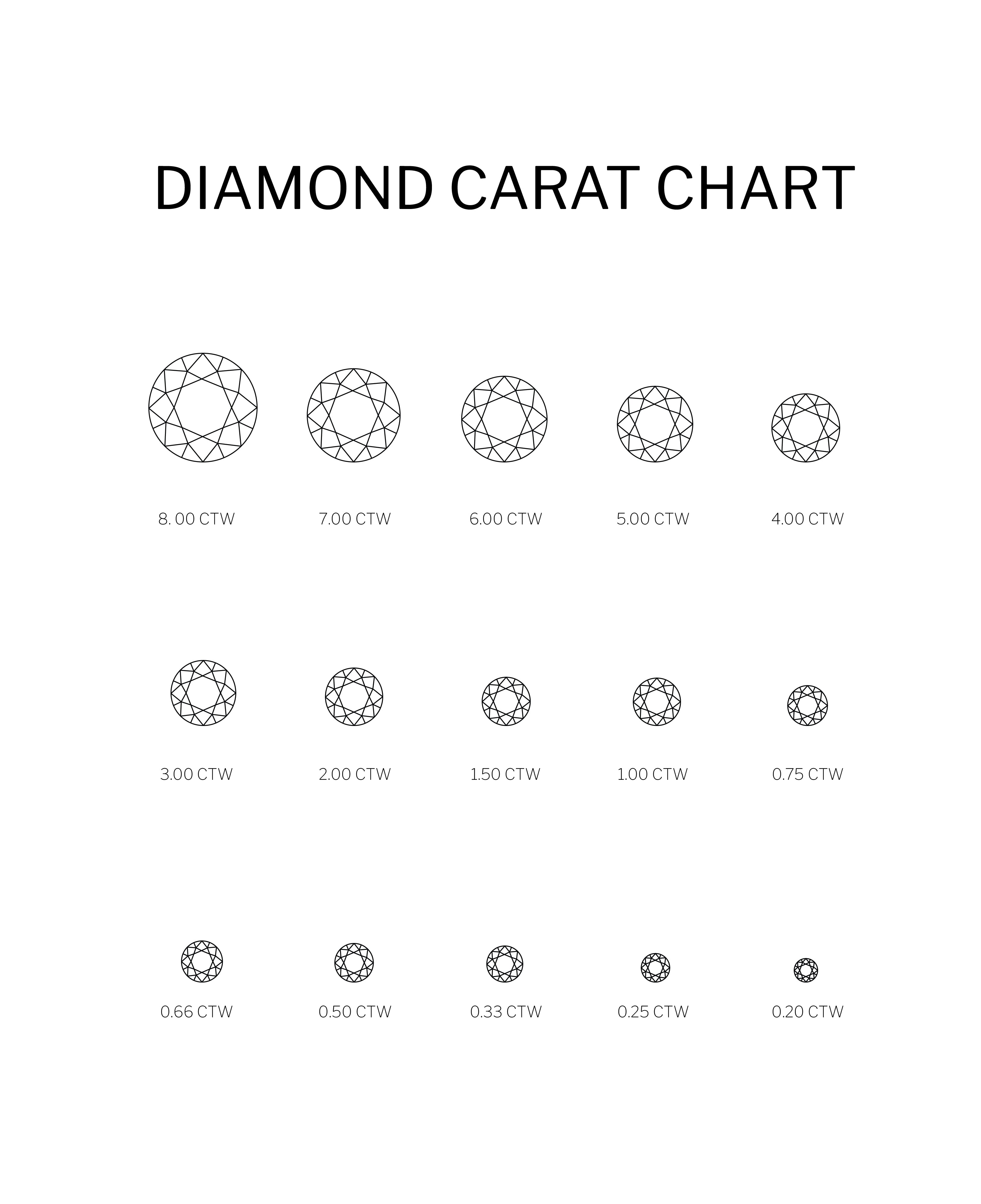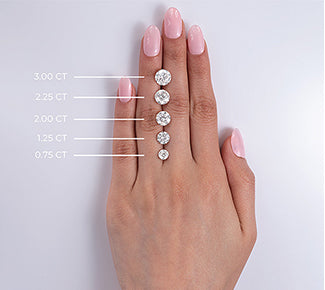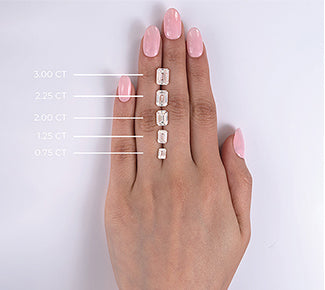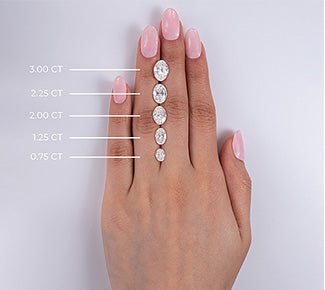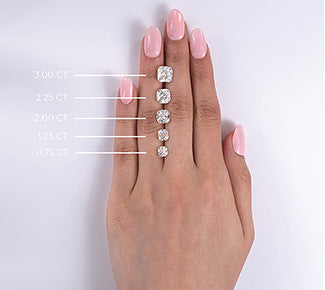What Are the 4Cs?
When it comes to buying diamonds, understanding the 4Cs is crucial. The 4Cs - cut, color, clarity, and carat - are the universally recognized characteristics determining a diamond's quality and value. Each C plays a significant role in evaluating a diamond's overall appeal and desirability, and understanding these characteristics will help you choose your perfect diamond.
Now that you know why the 4Cs are essential and that lab-grown diamonds are graded according to these characteristics, let's talk about each so you can think like a professional when selecting your diamond.
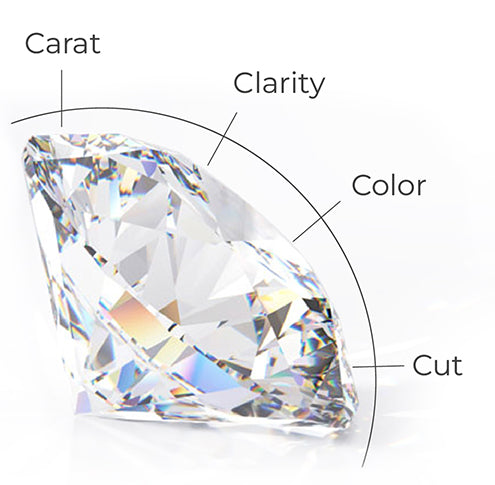
Now that you know why the 4Cs are important and that lab grown diamonds are graded according to these characteristics, let’s talk about each one so you can think like a professional when selecting your diamond.
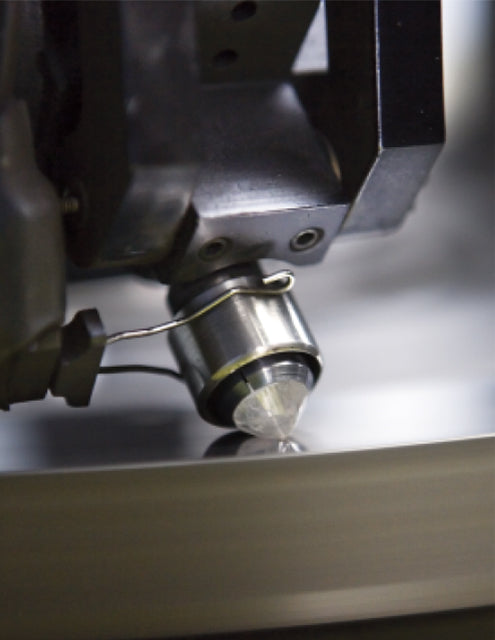
1. Cut
The cut of a diamond is the most important characteristic. It directly influences the diamond's sparkle and brilliance. A well-cut diamond reflects light in a way that maximizes its beauty. In contrast, a poorly cut diamond may appear dull and lifeless. The cut determines how effectively the diamond interacts with light, making it a crucial factor in enhancing its overall visual impact.
Types Of Diamond Cuts
When assessing the value of a diamond, one of the crucial factors to consider is cut quality, which determines how well a diamond will sparkle. The Gemological Institute of America (GIA) classifies diamond cut into five grades: Excellent, Very Good, Good, Fair, and Poor.
An excellent cut diamond reflects nearly all light that enters it, resulting in exceptional sparkle and brilliance. A very good cut diamond, while cheaper, still exhibits remarkable brilliance, and offers a great balance of beauty and price.
A good cut diamond adequately reflects most light that enters it, providing a good level of brilliance at a lower cost. A fair cut diamond, however, only reflects a small to moderate amount of light, and may appear dull. Lastly, a poor cut diamond reflects minimal light and is generally considered to be of low quality due to its dim appearance.
While all of these grades have their place in the market, understanding the impact of cut on a diamond's appeal is essential for making an informed purchase.
Round & Fancy Shape Diamond Cuts
There are two primary categories - round cuts and fancy shape cuts. The traditional and most popular diamond shape, the round cut, is renowned for its exceptional brilliance. It offers the maximum reflection of light due to its 58 facets, making it the go-to choice for those seeking the utmost sparkle.
On the other side, fancy shape cuts refer to all shapes other than round and include princess, oval, marquise, pear, heart, cushion, emerald, asscher, radiant, and more. Each shape brings unique aesthetic qualities, and the choice often boils down to personal preference. For instance, the princess cut is loved for its modern, sleek lines and is second in popularity only to the round cut. Oval cuts have an elongating effect on the finger, making them a favorite for engagement rings. Meanwhile, cushion cuts, with their vintage charm, have won the hearts of many, especially those seeking a romantic, antique look.
Remember, regardless of the shape, the cut quality will significantly influence the diamond's overall brilliance and beauty. Make sure to consider both aspects - the shape for the aesthetic appeal and the cut for the desired sparkle when choosing a diamond.
Grading fancy diamond cuts follows a different process compared to round cuts. The GIA (Gemological Institute of America), for instance, does not offer a cut grade for fancy shapes due to their diverse nature. However, there are some factors to consider when evaluating the quality of a fancy cut diamond.
The shape appeal assesses the symmetry, balance, and overall proportions of the diamond. A well-proportioned diamond will have a pleasing and balanced shape when viewed from above. The next factor is the brilliance, or how effectively the diamond reflects light. This is determined by the quality of the cut, which should aim to maximize light return through the top of the diamond.
The third factor is the scintillation, or the amount of sparkle a diamond produces, and the pattern of light and dark areas caused by reflections within the diamond. The scintillation will vary depending on the shape and cut style.
Lastly, check the diamond's polish and symmetry. The polish grade reflects the smoothness of the diamond's facets, while the symmetry grade assesses the precision of the diamond's shape and facet arrangement. Both of these factors can influence the diamond's light-reflecting qualities.
Remember, the grading of fancy cut diamonds is subjective, and personal preference plays a significant role in the selection process.
Brilliance, Dispersion, Fire & Scintillation
Brilliance, Dispersion, Fire, and Scintillation are significant aspects that contribute to a diamond's overall appeal and value. Understanding these factors can aid in making an informed decision when purchasing a diamond.
Brilliance refers to the ability of a diamond to reflect light back to the viewer. This is primarily determined by the cut of the diamond. The better the cut, the higher the brilliance, resulting in a more attractive and lively diamond.
Dispersion, often referred to as 'fire,' describes the way a diamond breaks down light into its spectral colors. When a white light enters a well-cut diamond, it's refracted and dispersed into all colors of the rainbow. The fire is the play of colors you see in a diamond when you move it under the light.
Fire is not to be confused with the term 'dispersion'. In the jewelry industry, 'fire' refers to the flashes of color you see in a diamond. The fire in a diamond is particularly observable in low light conditions where the stone can break light into its spectral colors.
Scintillation is the flash or sparkle you see when the diamond, the light, or the observer moves. It refers to the quantity and quality of these flashes when the diamond is viewed under light. A well-cut diamond will have a lot of scintillations, contributing to its overall beauty and allure.
A diamond's cut significantly determines its Brilliance, Dispersion, Fire, and Scintillation. Hence, while purchasing a diamond, it is necessary to consider these aspects to ensure that you choose a stone that truly sparkles.
2. Color
Diamonds are graded on a color scale ranging from D (colorless) to Z (light yellow or brown). The presence of color in a diamond can greatly affect its beauty and value. Generally, the more colorless a diamond is, the more desirable it becomes. However, personal preferences and budget considerations also play a role in selecting a diamond color.
What is the Diamond Color Scale?
The Diamond Color Scale is a standardized grading system for evaluating the hue of a diamond. The color of a diamond plays a crucial role in its overall appearance and value. According to the Gemological Institute of America (GIA), diamonds are graded for color on a scale from D (colorless) to Z (light yellow or brown).
Colorless diamonds (D-F) are the most desirable and valuable due to their rarity. These diamonds allow most light to pass through, resulting in exceptional brilliance. Near colorless diamonds (G-J) display slight hints of color, but are much less expensive, making them a popular choice for those balancing quality and cost.
Diamonds in the faint (K-M), very light (N-R), and light (S-Z) color ranges possess noticeable color, typically a yellow or brown hue. While these diamonds can still be beautiful, they are less sought after than higher grades.
It's also important to note that color becomes harder to detect in a diamond once it's set in a ring and viewed from the side or top (which is typically how diamonds are viewed). So while color is important, it's not as critical to a diamond's appearance as its cut.
In the case of fancy color diamonds, which come in blues, reds, greens and other vibrant hues, the grading system is different. For these gems, a more intense color is highly desirable and thus, more highly valued.
Remember, the diamond color scale is one of many factors to consider when selecting the perfect stone. Each diamond is unique, and the right choice ultimately depends on individual preferences and budget.
How to Use Diamond Color to Best Set Diamonds?
Setting a diamond according to its color is both an art and a science. It's a process that requires an understanding of the diamond color scale and an appreciation for the interplay of the gem with the chosen setting.
For diamonds in the 'D-F' range, considered colorless, the color of the setting should not compete with the diamond's purity. Platinum or white gold settings are ideal for showcasing their brilliance, as the white metal complements the diamond's lack of color.
For near-colorless diamonds in the 'G-J' range, you still have the flexibility to opt for either white or colored metals. While white metals can help mask any slight yellowish tints, these diamonds also complement yellow and rose gold settings wonderfully, enhancing their warm tones.
Diamonds in the 'K-Z' range, with noticeable color, often pair well with yellow gold or other colored metals. These settings can help mask the diamond's color, making it appear whiter.
Fancy colored diamonds, with their vibrant blues, reds, greens and other hues, call for a more thoughtful approach. The setting should be chosen to enhance and highlight the diamond's color. For example, a blue diamond might be set in white gold to contrast and accentuate its color, while a red diamond might be paired with a yellow gold setting to promote warmth.
Remember, the setting can significantly influence the diamond's appearance. A well-chosen setting can elevate a diamond's color grade, while a poor choice can detract from its beauty. Ultimately, the perfect match depends on the diamond's color, the intended wear, and personal aesthetic preferences.
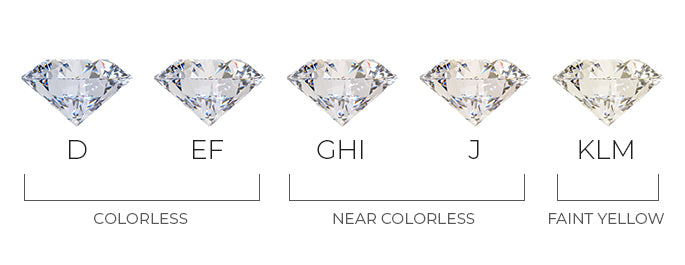
Clarity
Clarity is another essential factor to consider when assessing diamond quality. Clarity refers to the presence of internal or external flaws, known as inclusions and blemishes, respectively. The fewer and less visible the flaws, the higher the diamond's clarity grade. However, it is advisable to evaluate clarity based on what is perceptible to the naked eye, as microscopic flaws may not impact the diamond's beauty significantly.
How to Grade Diamond Clarity
Diamond clarity is a crucial aspect to consider when evaluating a diamond's quality. The Gemological Institute of America (GIA) has developed a grading system to assess diamond clarity based on the presence of internal or external characteristics known as 'inclusions' and 'blemishes' respectively.
The clarity grading scale ranges from Flawless (no inclusions or blemishes visible under 10x magnification) to Included (inclusions and/or blemishes visible to the naked eye). The grades from highest to lowest are: Flawless (FL), Internally Flawless (IF), two categories of Very, Very Slightly Included (VVS1 and VVS2), two categories of Very Slightly Included (VS1 and VS2), two categories of Slightly Included (SI1 and SI2), and three categories of Included (I1, I2, and I3).
When grading diamond clarity, several factors are considered, including the size, nature, position, color or relief, and quantity of clarity characteristics. It's important to remember that many inclusions and blemishes are too tiny to be seen by anyone other than a trained diamond grader. To the naked eye, a VS1 and an SI2 diamond may look exactly the same, but these diamonds are quite different in terms of overall quality.
Diamond Shapes and Clarity
Just as clarity is vital when choosing diamonds, shape also plays a significant role. Each diamond shape reflects light in unique ways, and the shape you choose can significantly affect the diamond's clarity perception.
The round brilliant cut, for instance, is renowned for its superior light performance. This shape can hide inclusions and blemishes more effectively due to its many facets, hence, a lower clarity grade (like SI1 or SI2) could still look flawless to the untrained eye.
On the other hand, step-cut diamonds such as emerald and Asscher cuts have larger, open facets that act like clear windows into the diamond. These shapes magnify the diamond's interior, making inclusions and blemishes more apparent. For this reason, a higher clarity grade (like VS1 or VS2) is often recommended for these shapes.
Oval, marquise, and pear shapes, known as modified brilliant cuts, have elongated shapes that can display inclusions near the pointed ends. With these shapes, selecting a diamond with a higher clarity grade ensures a clean appearance.
The princess-cut diamond, with its sharp corners and complex facet structure, can hide inclusions effectively. A medium to high clarity grade would be suitable for this shape.
When choosing a diamond, both the shape and the clarity should be taken into consideration. Remember, every diamond is unique. Understanding how clarity interacts with diamond shape helps you make an informed decision for your perfect gem.
Carat
A diamond carat is a unit of measurement used to determine the weight of a diamond. One carat is equal to 200 milligrams, and each carat is further divided into 100 points for diamonds below one carat. The carat weight of a diamond does not necessarily determine its size, as factors like shape and cut can influence how large a diamond appears. It is important to consider the wearer's preferences, budget, and the overall quality of the diamond when choosing a carat weight.
How Carat Affects Diamond Size and Appearance
A larger carat weight doesn't always equate to a bigger looking diamond. The diamond's cut and shape can significantly affect how large it appears. For example, a well-cut diamond will look larger than a poorly cut diamond of the same carat weight, due to superior light performance and reflection.
Diamond size specifically refers to the physical size of the diamond, measured in millimeters across the top of the stone. The visible size heavily depends on the diamond's cut and shape, and it's crucial to note that a larger size doesn't necessarily mean better quality or brilliance.
Lastly, a diamond's appearance is influenced by a combination of its carat, size, color, clarity, cut, and shape. For instance, a high-carat weight diamond with poor clarity or a dull color may not be as appealing as a smaller diamond of better quality. The diamond's cut can also significantly influence its appearance— a superior cut grade ensures a diamond reflects light brilliantly, making it appear larger and more brilliant.
In the end, choosing a diamond isn't just about its carat or size, but also its overall appearance and how these factors harmonize. It's about finding a diamond that matches your preferences and resonates with you, making the choice truly personal and unique.
How Carat Affects Price
The carat weight of a diamond substantially affects its price due to the rarity of larger diamonds. Price per carat increases exponentially with carat weight. For instance, a two-carat diamond doesn't just cost twice the price of a one-carat diamond; it costs significantly more because two-carat diamonds are less commonly mined than one-carat diamonds. This rarity factor, combined with the demand for larger diamonds, drives up the prices substantially. However, it's crucial to remember that carat weight is just one factor influencing a diamond's price. Aspects such as color, clarity, cut, and shape also play vital roles in determining the final cost of a diamond.
What To Know About Carat When Buying a Diamond
When purchasing a diamond, understanding the carat weight is vital. However, it's equally important to know that a larger carat weight doesn't always equate to a larger looking diamond. Two diamonds of the same carat weight can appear different sizes depending on how the diamond is cut. Some diamonds can be cut shallow or deep, allowing for a larger surface area, but this often sacrifices the diamond's ability to refract light, diminishing its brilliance.
Buyers should also be cautious about hitting precise carat weights like 1.0, 1.5, or 2.0, as prices tend to jump at these points. Instead, consider buying a diamond that's slightly below these weights — for instance, a 1.9-carat diamond instead of a 2.0. The slight reduction in carat weight is practically unnoticed visually, but can save a significant amount of money.
Lastly, balance is key in choosing a diamond. Don't sacrifice clarity or color for a larger carat size. A smaller, high-quality diamond will have more sparkle and brilliance than a larger, lower-quality one. The best diamond is one that achieves a balance of size and quality that suits your personal taste and budget.Understanding the 4Cs - cut, color, clarity, and carat - is pivotal when purchasing a diamond. The cut determines the diamond's sparkle, while the color influences its overall beauty. Clarity helps assess the presence of flaws, and carat weight determines the size of the diamond. By considering each of these factors in combination, buyers can make informed decisions and select a diamond that meets their preferences and budget while ensuring exceptional quality.
Understanding the 4Cs - cut, color, clarity, and carat - is pivotal when purchasing a diamond. The cut determines the diamond's sparkle, while the color influences its overall beauty. Clarity helps assess the presence of flaws, and carat weight determines the size of the diamond. By considering each of these factors in combination, buyers can make informed decisions and select a diamond that meets their preferences and budget while ensuring exceptional quality.
